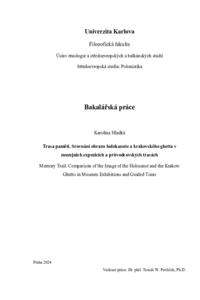Trasa paměti. Srovnání obrazu holokaustu a krakovského ghetta v muzejních expozicích a průvodcovských trasách
Memory Trail. Comparison of the Image of the Holocaust and the Krakow Ghetto in Museum Exhibitions and Guided Tours.
bakalářská práce (OBHÁJENO)

Zobrazit/
Trvalý odkaz
http://hdl.handle.net/20.500.11956/192201Identifikátory
SIS: 261267
Kolekce
- Kvalifikační práce [23745]
Autor
Vedoucí práce
Oponent práce
Škvrňák, Jan
Fakulta / součást
Filozofická fakulta
Obor
Středoevropská studia: Polonistika
Katedra / ústav / klinika
Ústav etnologie a středoevropských a balkánských studií
Datum obhajoby
12. 6. 2024
Nakladatel
Univerzita Karlova, Filozofická fakultaJazyk
Čeština
Známka
Výborně
Klíčová slova (česky)
turismus|místa paměti|ghetto|Muzeum Krakowa|holokaust|antisemitismus|Kazimierz|Podgórze|Tadeusz PankiewiczKlíčová slova (anglicky)
tourism|places of memory|ghetto|Muzeum Krakowa|Holocaust|antisemitism|Kazimierz|Podgórze|Tadeusz Pankiewiczv českém jazyce Tato bakalářská práce se zabývá komparací průvodcovské trasy a tematické muzejní "Trasy paměti", zahrnující místa spojená s holokaustem v Krakově za druhé světové války. Cílem práce je obohatit stávající "Trasu paměti" Muzea Krakowa o novou lokalitu na základě inspirace knihou "Apteka w getcie krakowskim" Tadeusze Pankiewicze. Všechny pobočky Muzea Krakowa jsou doplněny o inovace zvyšující atraktivitu pro návštěvníka. Autorka pracuje s konceptem míst historické paměti a analyzuje způsob jejich prezentace současným turistům. Na základě zjištění z vlastního rozhovoru s turistickým průvodcem sleduje, na kolik a jakým způsobem jsou jednotlivé historické a paměťové objekty "Trasy paměti" zapojeny do turistických okruhů.
in English This bachelor's thesis deals with the comparison of the guided tour and the thematic museum route "Memory trail", which includes places connected with the Holocaust in Krakow during the Second World War. The aim of the thesis is to enrich the existing "Memory trail" of the Museum of Krakow with a new location based on the inspiration of the book "The Krakow Ghetto Pharmacy" by Tadeusz Pankiewicz. All branches of the Museum of Krakow are supplemented with innovations increasing the attractiveness for the visitors. The author works with the concept of places of historical memory and analyses the way they are presented to contemporary tourists. Based on the findings of the author's own interview with a tourist guide, she observes to what extent and in what way the various historical and memory objects of the "Memory trail" are integrated into the tourist circuits.
